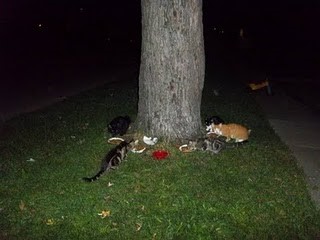Attached are pictures of various cats around town. These cats are fine in the summer, being without shelter, but come winter, its a very harsh existence for them. Can you imagine, a city so cruel as to want to remove the shelters I have established for them? You can't just move the cats that are 'living' there. Once spayed and neutered, they die out on their own. Until then, they need sustenance and safety. I have not yet heard back from the city, but am waiting.
Click on pics to zoom in:
Removing cats from an area creates a vacuum.
The Vacuum Effect has been documented worldwide in many species. Animal control’s traditional approach has been to catch and kill community cats. While this may temporarily reduce the number of community cats in a given area, it is ultimately counterproductive, as the population of cats rebounds. Due to the Vacuum Effect, untrapped cats continue to breed, and other cats move into the newly available territory.
Community cats are unowned cats who live outdoors.
Community cats, also called feral or outdoor cats, are not a new phenomenon. They reside in an outdoor location where they have access to food and shelter. Even though community cats are the same species as house cats (Felis catus), they have not been socialized to people and are therefore unadoptable. Community cats can lead full, healthy lives in their outdoor homes.
Time and again, communities find catch and kill doesn’t work—it needs to stop.
Municipal animal control agencies have been catching and killing cats for decades in a misguided attempt to reduce the number of community cats in a given area. Catch and kill is counterproductive, as it has no permanent impact on the population of outdoor cats. This endless, cruel cycle is not supported by the public, wastes tax dollars, and fails to meet the needs of the cats and the community. The Vacuum Effect is just one reason catch and kill is so ineffective.
Trap-Neuter-Return (TNR) does work.
Communities are desperate for humane solutions. TNR is the only effective and humane approach to address community cat populations. It involves humanely trapping, spaying or neutering, vaccinating, and returning community cats to their outdoor homes. Afterward, there are no more litters of kittens—the population is stabilized. TNR stops the stress associated with pregnancy and mating behaviors, such as yowling or fighting. Not only is TNR the effective, humane approach for outdoor cats, but it improves their lives.
You can make a difference and save lives.
Together, we can fight the ineffective catch and kill approach, support TNR, and ensure local policies address the needs of outdoor cats and our communities.








No comments:
Post a Comment